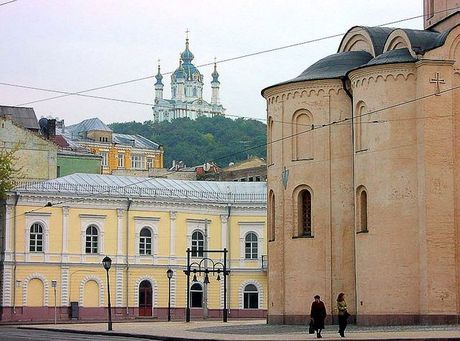Podol
Podol (or Podil) is an old district of Kiev, where craftsmen and fishermen used to live. The district was formed after fire of 1811, when all the wooden constructions burnt down. Several slopes, including the famous Andreevsky Spusk, lead to Podol. The compositional center of Podol is large Kontraktovaya Square, where each house is interesting in its own way. Since 1798 the square was the place for al Russian fairs, and for the needs of customers the Merchants' Yard was put up. It contained 50 stores with various goods and products. Unfortunately the original building didn't survive until today, and the new building of the same look was constructed. Near the Merchants' Yard there is the fountain Samson, designed by Ukrainian architect Grigorovich-Barsky in 1749. The fountain is object of many legends, one of which says that the one who tries "Samson water" will stay in Kiev forever.
The Podol or Podolskyi Raion is a historic neighbourhood and an administrative raion (district) in Kiev, the capital of Ukraine. It is one of the oldest neighborhoods of Kiev, the birthplace of the city's trade, commerce and industry. It still contains many architectural and historical landmarks, and new archeological sites are still being revealed.
Numerous attractions of Podol particularly include: Frolivskyi and Pokrovskyi Convents, National University of Kyiv-Mohyla Academy, House of Ivan Mazepa, House of Peter the Great, Fountain of Samson, Zamkova Hora hill, Andriyivskyy Descent — the main link of Podol to the city's administrative Uppertown, Borychiv Descent, Kiev River Port, Kiev funicular, Poshtova Square, and the Kontraktova Square.
Modern Podolskyi Raion, despite it's tourism and culture importance, remains one of Kiev's main business, transportation and industrial districts. Industrial sites are mostly phased out of the Podol proper, but dominate the adjacent neighborhoods to the north.
In this old district of Kiev there is the block of Kievo-Mogilyanskaya academy that was founded in 1632 and became the center of Orthodox education of Slavonic people. Such historical persons as Lomonosov, Skovoroda, Miloradovitch and many other studied in the academy.
In Podol there is a monument to outstanding Ukrainian philosopher Grigoriy Skovoroda. He is famous for wandering around Ukraine and teaching people the laws of morality. He was against ostentatious religious devotions and propagated harmonious union of faith and mind.
In Podol there are many attractions. Among them is functioning Florovsky Convent built in the 15th century and restored in the 19th century, elegant Iliinskaya Church that was built on the very place where ambassadors of prince Igor took an oath while making peace with Greeks. Nikola Pritisk Church, which is functioning now, looks like an old wooden Ukrainian temple. And when one is inside he or she might feel the atmosphere of the past.
Near the Florovsky Convent used to be the first drug store in Kiev. Nowadays the building contains the museum of pharmaceutics and one of the largest drug stores in the city.
The Podilskyi Raion, as an administrative entity, was formed in 1921 on one of the largest historical neighborhoods in Kiev. In May 2001, Podil celebrated its 80th anniversary of its foundation. Within the raion include the: Vynohradar, Kurenyovka, a part of Nyvky, Rybalskyi Peninsula, Mostytskyi, and the Podil historical neighoborhood itself. The section just north of Nizhnii Val was formerly called Ploskaya chast' or Ploskaya sloboda and until World War II was home to many poor Jews living in wretched conditions. On the territory of the Podilskyi Raion lie about 50 large industrial organizations, some of which are world renowned: Kiev Factory of Champagne Wines, Stolichnyi, Beer factory at Podil, Kiev Vitamin Factory, and the Farmak Factory.




